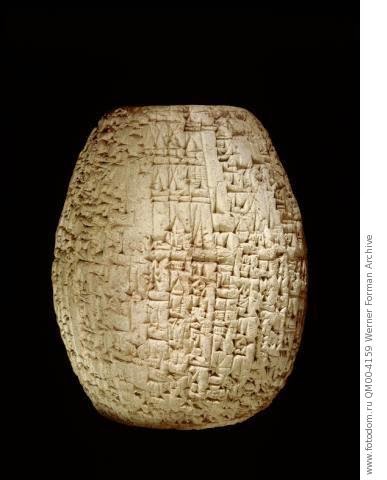jueves, 29 de enero de 2015
Hollow clay cylinder inscribed in cuneiform
Hollow clay cylinder inscribed in cuneiform, describing Sin-iddinam's dredging of the Tigris on behalf of various deities. Translation of the text on request. Culture: Sumerian. Date/Period: c. 1850-1843 BC. Place of Origin: Sumeria, Ancient Iraq. Material Size: clay, l = 12.3 cms. Credit Line: Werner Forman Archive/ Sold at Christie's London (1998) . Location: 08.
Stone relief from the Palace of Ashurbanipal
Stone relief from the Palace of Ashurbanipal. The King hunting lions, detail. Culture: Assyrian. Date/Period: Late Assyrian 668 - 627 BC. Place of Origin: Nineveh, Assyria, Ancient Iraq. Credit Line: Werner Forman Archive/ British Museum, London . Location: HR.
A reconstruction of the Ishtar gate
A reconstruction of the Ishtar gate which was decorated with polychrome glazed bricks and was built by Nebuchadnezzar II. Detail of a bull. Culture: Babylonian. Date/Period: c.570 BC. Place of Origin: Babylon, Ancient Iraq. Material Size: Polychrome glazed brick. Credit Line: Werner Forman Archive/ State Museum, Berlin . Location: 09.
martes, 27 de enero de 2015
domingo, 18 de enero de 2015
Seal . Neo-Babylonian Period
Seal depicting a bare-headed priest before divine symbols of the goddess Ishtar (star) and the god Sin (moon crescent) set on altars. This is the commonest motif in the Neo-Babylonian cylinder and stamp seals. Mesopotamia. Culture: Neo-Babylonian Period: 1000-539 BC Material: Agate. Credit Line: Werner Forman Archive/ British Museum, London
jueves, 15 de enero de 2015
Zodiac of the Bull.
Wall painting from a temple depicting the Zodiac of the Bull. The bull is also a symbol of spring, as is the branch of a peach tree held by the central female figure. The peach, here held in a basket by a monkey, was considered a magic fruit that conferred immortality. Country of Origin: China. Culture: Chinese. Date/Period: late Ming/c.17th AD. Place of Origin: Shanxi/Hebei. Material Size: 0.90m x 1.12m. Credit Line: Werner Forman Archive/ Musees Royaux d'Art et d'Histoire Brussels, VER.110. Location: 12.
Humanoid bird mask
Humanoid bird mask. Country of Origin: Northwest Coast of America. Culture: Tsimshian or Tlingit (Klukwan). Date/Period: early 19th C. Credit Line: Werner Forman Archive/ Private Collection. Location: 32.
Frontlet worn by a chief attached to his headdress
Frontlet worn by a chief attached to his headdress. It represents a perching eagle. Country of Origin: Northwest Coast of America. Culture: Tsimshian. Perido/ Date: early 19th C. Material Size: wood, abalone shell. Credit Line: Werner Forman Archive/ Private Collection Location: 33.
Suscribirse a:
Entradas (Atom)










